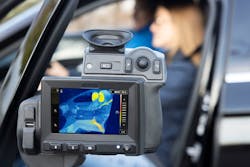Buckle up to save energy: ZF’s new heated seat belt unveiled at CES
At the recent Consumer Electronics Show (CES) that wrapped up last week, ZF unveiled some interesting new technology aimed at improving the range and performance of future EVs. One thing that caught our eye, and which seemed a little strange, is the company’s new heated seat belts. Yes, seat belts with heaters.
Upon further inspection, however, it’s actually a smart idea, and here’s why: EVs have a persistent range problem. Not only is every manufacturer looking for ways to improve the range of their battery-electric vehicles, but they also need to perform in all kinds of weather conditions. “Snowmaggedon” is not that far in the review that we have forgotten Christmas of 2022. In the North, we hit some brutally cold temperatures with windchills in the double digits below zero. Aside from those cold temperatures on the skin, it doesn't mix well with lithium battery chemistry either.
Subsequently, Tesla’s cold weather performance is now coming under scrutiny in South Korea. The country’s Fair Trade Commission alleges that the EV manufacturer exaggerated the driving ranges of its cars on a single charge and is being fined $2.2 million. However, EVs still need to heat exchangers and pumps to keep cabin occupants and drivers comfortable, but the inherent issue with this more “traditional’ way of cabin heating is that it wastes a lot of energy.
It takes more power to crank up the heat than if the driver had some other lower-voltage way of staying warm and comfy. According to AAA, “Cold weather can cut electric vehicle range by more than 40 percent.” EVs often lose 12 percent of their range in cold weather, but the loss can jump to 41 percent with the heater on full blast.
A climate control system in a typical EV is powered by battery current, as there is no usable waste heat as with the combustion engine. Reducing the amount of battery current used to heat the vehicle's interior may enable a gain of up to 15 percent range using contact heaters and reducing the usage of conventional climate control systems. With an integrated heating function, ZF’s new heated seat belt can provide close-to-body warmth immediately after the driver starts driving, typically between 96 -104 degrees F (36 - 40 degrees C). In combination with heated seats, the heated seat belt has the potential to provide occupant comfort quickly, according to the company.
The special webbing with integrated heating conductors woven in minimally increases the thickness of the webbing. This makes integration easier for vehicle manufacturers and offers occupants the same comfort as a normal seat belt.
Of course, drivers can control their accessories to reduce battery usage, but why would you want to freeze or wear gloves and a puffy jacket when you can travel in comfort and warmth at a minimal cost to your battery range?



